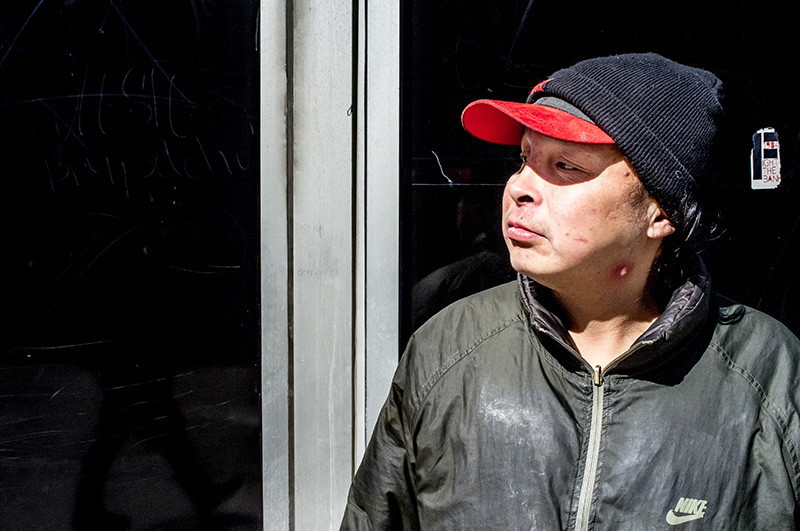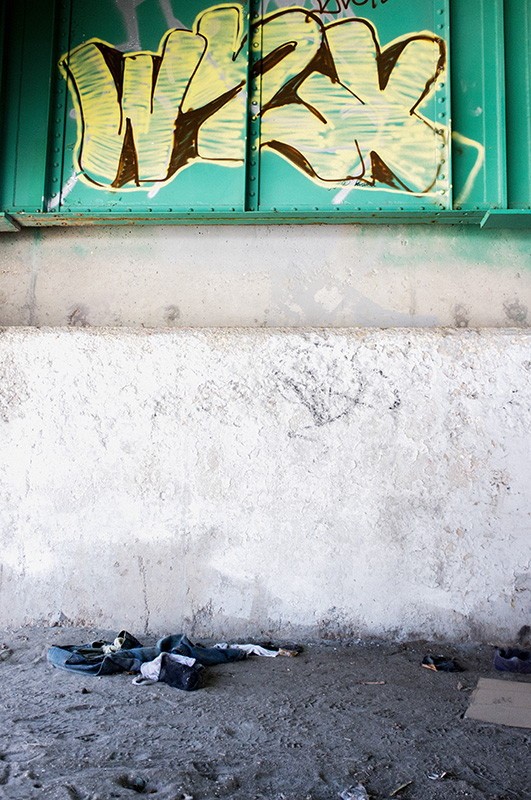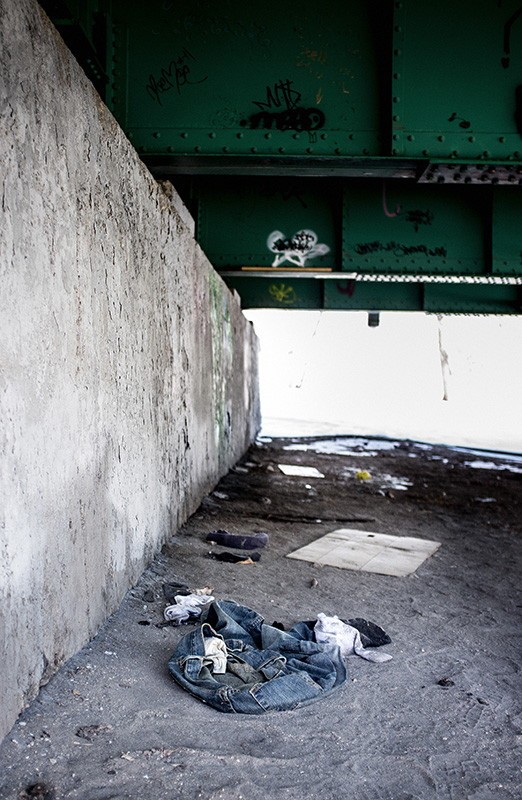A better approach to reducing homelessness
How could Winnipeg be improved? The Uniter put together a list of ideas… This is the first in the series, to view the next article click here.
As many people his age are preparing to trade in their work boots for loafers, Eric Spencer doesn’t see any cruise ship tours on his horizon.
Spencer, a 62-year-old unemployed audio-visual technician and father of seven, has managed to keep a roof over his head at the Main Street Project emergency shelter for the past two years since police picked him up from a bus shelter he was sleeping in at the time.
“I was getting drunk every day,” says Spencer, who continues to struggle with addictions, and who’s slept everywhere from back alleys to riverbanks. “I had nowhere to go.”
Spencer’s grateful for the support he’s received at the Project, but he wishes other Winnipeggers could understand his struggles.
“It’s hard,” he says. “I want to rehabilitate myself, but the thing about that is it’s really, really hard.”
While Spencer may belong to a minority demographic in the city, his situation is far from exceptional.
According to a recent study by the Social Planning Council of Winnipeg, an average of 353 Winnipeggers stay in emergency shelters on a given night, while an indiscernible number sleep in cars, derelict structures, semi-public spaces or completely outdoors.
Standing outside of Siloam Mission on Princess Street, Wanda, who chooses not to disclose her full identity for personal safety reasons, says she’d be sleeping on the streets if it weren’t for local shelters like Siloam.
Since leaving an abusive partner last month, the middle-aged woman has managed to keep a pillow under her head between Siloam and Osborne House.
It’s what comes next that Wanda is most concerned about.
“Housing is the biggest problem,” she says, noting the rental allowance for welfare recipients in the city often limits people in situations like hers to staying in the cheap, unsafe and poorly maintained hotels and boarding houses lining the area.
According to Dennis Lewycky, executive director of the SPCW, one of the ways Winnipeggers need to alter their approach to homelessness is by broadening the colloquial definition of the word, which tends to conjure images only of “absolute” homelessness.
“Homelessness is simply when you don’t have a secure place to live,” explains Lewycky, noting that there are between 700 and 1,000 “houseless” people living out of single occupancy hotels and roughly 1,400 couch-surfers who have no other alternatives.
While assertions that no one has to be homeless in a welfare state like Canada due to social assistance are common in the public discourse, Lewycky points out current housing allowances - without even considering addiction and mental health issues - often just don’t cut it.
“We’ve created this situation where housing is so expensive and so difficult to find, that to find accommodation for under $500 a month is almost impossible,” he says.
“Our society is a wealthy one - there’s no reason why people should be unable to afford adequate housing.”
According to Lindsay Brown, Siloam’s director of volunteer services, housing isn’t just an issue when it comes to homelessness - it’s the issue.
“We need a real national housing strategy,” she says.
Siloam Mission, which operates a dry, 110-bed emergency shelter facility in addition to offering no-charge meals, clothing, medical services and employment training to patrons, has set itself a bold goal to tackle just that issue, which it calls “Vision 500”.
“The idea is to build 500 units of housing and create 500 jobs in the inner city in the next five years,” says Brown.
The organization’s first step was Madison Lodge, an 85-unit supportive “dry community housing” complex it opened in Wolseley last year, Brown noted.
However, for many homeless Winnipeggers, the search for housing comes second to more immediate needs.
Rick Lees, director of community services for the Mount Carmel Clinic on Main Street, says the physical and mental health states of many of its homeless patients can be alarming.
“You’re dealing with even basic issues of nutrition; of proper clothing. Given our climate, some of these people find themselves at very serious immediate risk,” Lees said.
“Many of their states are fragile, and many are substance abusers.”
Mount Carmel has an initiative called the Assertive Community Treatment program devoted specifically to assisting homeless individuals with severe, persistent mental health issues, Lee notes.
Still, a concrete homelessness strategy for the city - something Winnipeg currently lacks - is needed to better address homeless and low-income individuals’ health needs more efficiently, Lee suggests.
“Because these types of organizations are funded through different levels of government, everything’s very scattered,” he said.
“We need to have a unified plan to deal with these issues effectively.”
Stefano Grande, executive director of the Downtown Business Improvement Zone, says as much as the city needs to work on housing and addressing the immediate needs of the homeless population, it’s rehabilitation and ongoing support programs that are most desperately needed.
After years of running an outreach program meant to manage public intoxication in the area by escorting intoxicated homeless individuals to emergency shelters, the organization decided it needed to shift its focus, Grande said.
“It was the same people year after year after year after year (we were removing from the streets),” Grande said.
“We quickly realized that there needs to be solutions to helping that person off the street permanently.”
“ Homelessness is simply when you don’t have a secure place to live.
Dennis Lewycky, executive director, Social Planning Council of Winnipeg
With the city’s renewed push to spark core area development with its Sports, Hospitality and Entertainment District (SHED) strategy, Jino Distasio, director of the University of Winnipeg’s Institute for Urban Studies, urges Winnipeggers to look beyond superficial reductions of inner-city homelessness.
“Do we really think that if Winnipeg’s downtown is free of the visibility of poverty and homelessness we’ve actually ended it? That we’ve somehow cured poverty and homelessness because we don’t see them?” Distasio said.
“Or is the intent of these policies simply to brush poverty aside and hide it?”
“We have to think of that as a fundamental policy question,” he adds.
“We can either settle for moving poverty and homelessness elsewhere, or we can actually work at making meaningful change. Those are two distinctly different policy directions.”
Curt Pankratz, a professor of sociology at the University of Winnipeg, suggests a culture willing to more or less accept the existence of homelessness in the presence of First World-wealth is the product of a pervasive socialization process.
According to Pankratz, such a relative acceptance requires a general belief in equal opportunity - that individuals are not limited or determined by their socio-economic conditions - and the implicit insistence of the same ideology by media and other agents of socialization, like parents.
It’s important to always consider the structural forces underlying our perspectives on homelessness, Pankratz argues.
“You’ll almost never see mainstream media blame capitalism as a system for anything,” he says. “If there’s a financial meltdown; if poverty increases; if people are losing their homes; if homelessness is going up - it’s always a few bad apples (that are blamed), not the system itself. If you see poverty or homelessness in other places, on the other hand, we often blame their (socio-economic) structures as being the cause.”
As for Spencer, who, despite his situation, seems to prefer a sense of humour to one of despair, life remains a matter of taking it one day at a time.
“I don’t know if things are going change for me,” he says.
“I hope so, though. I’m still trying.”
Part of the series: The Urban Issue 2013
Published in Volume 67, Number 25 of The Uniter (March 28, 2013)









